
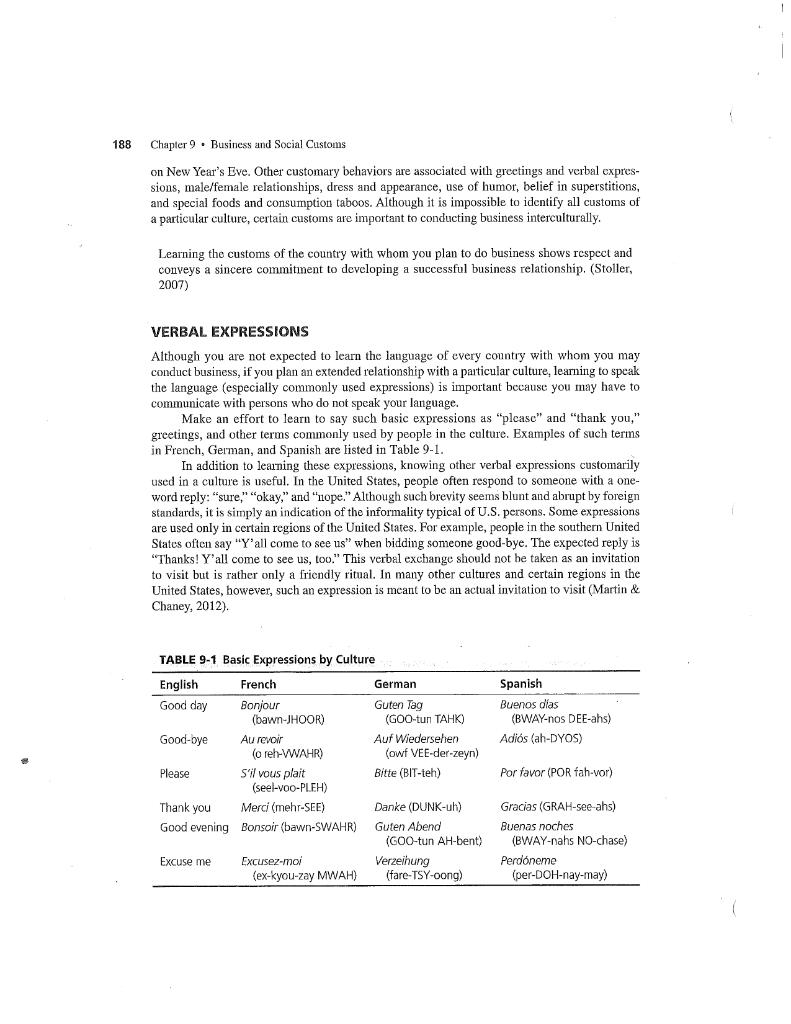
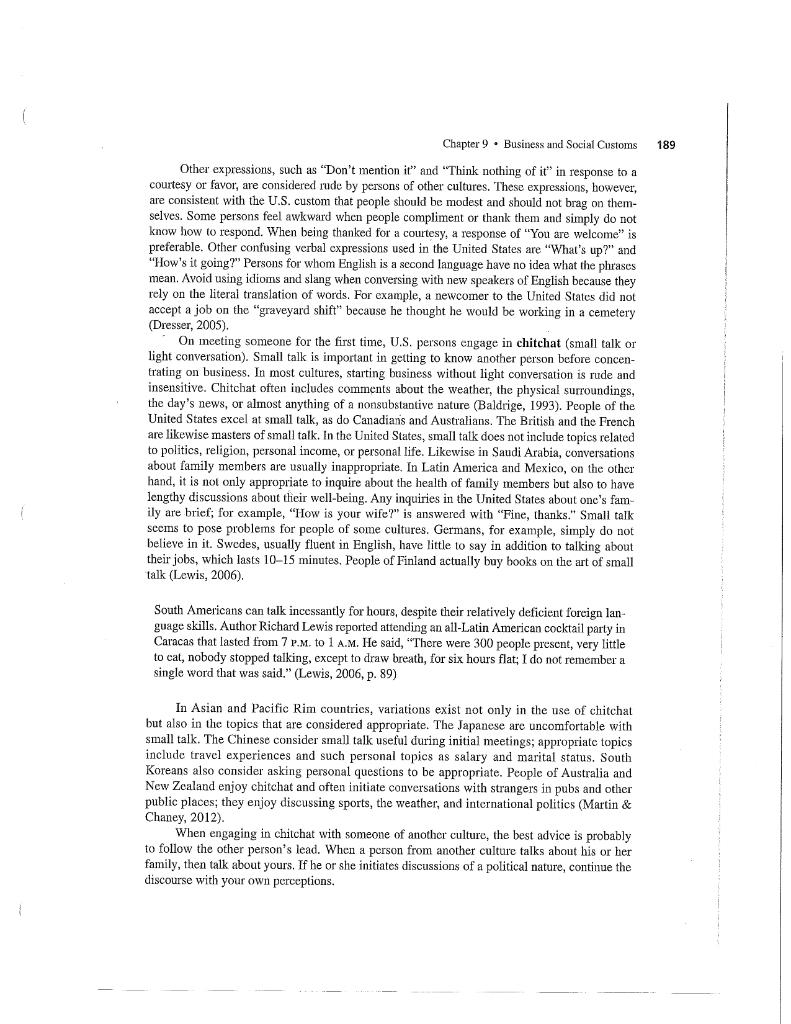
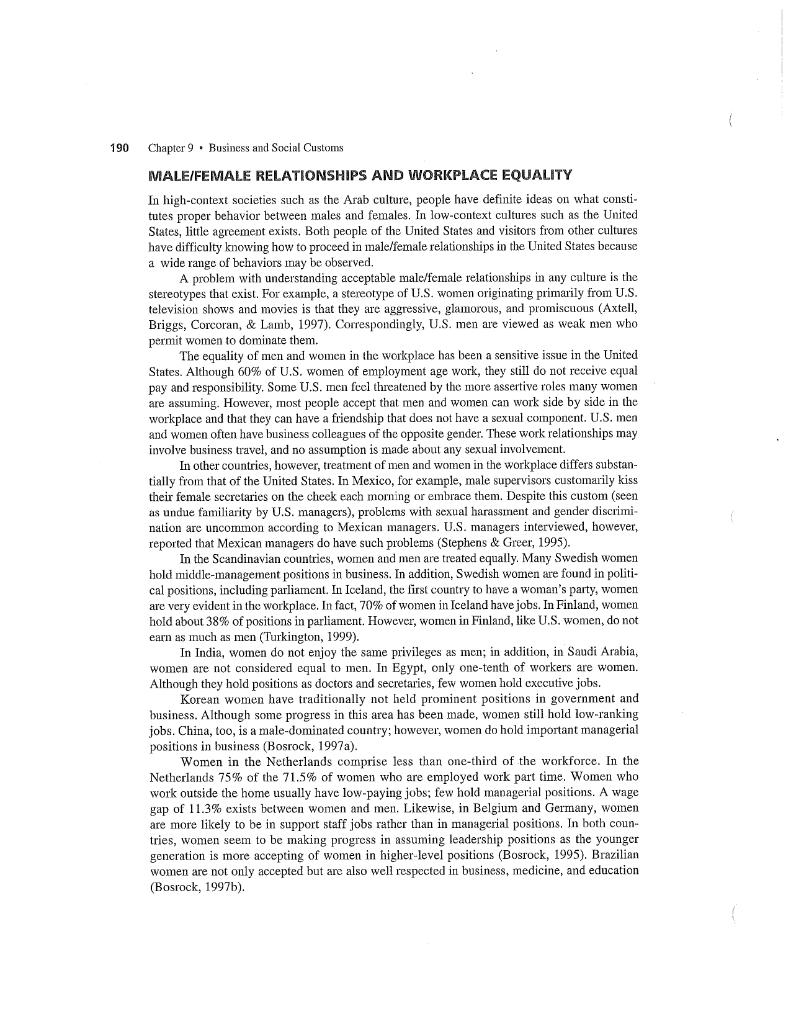
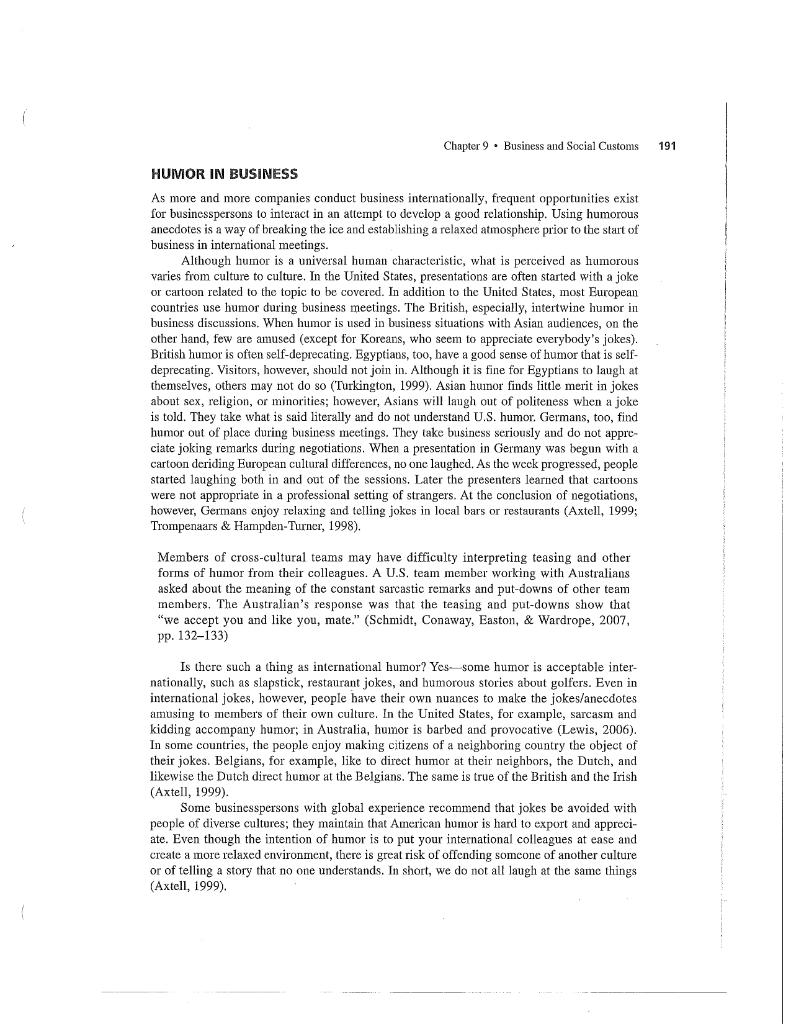
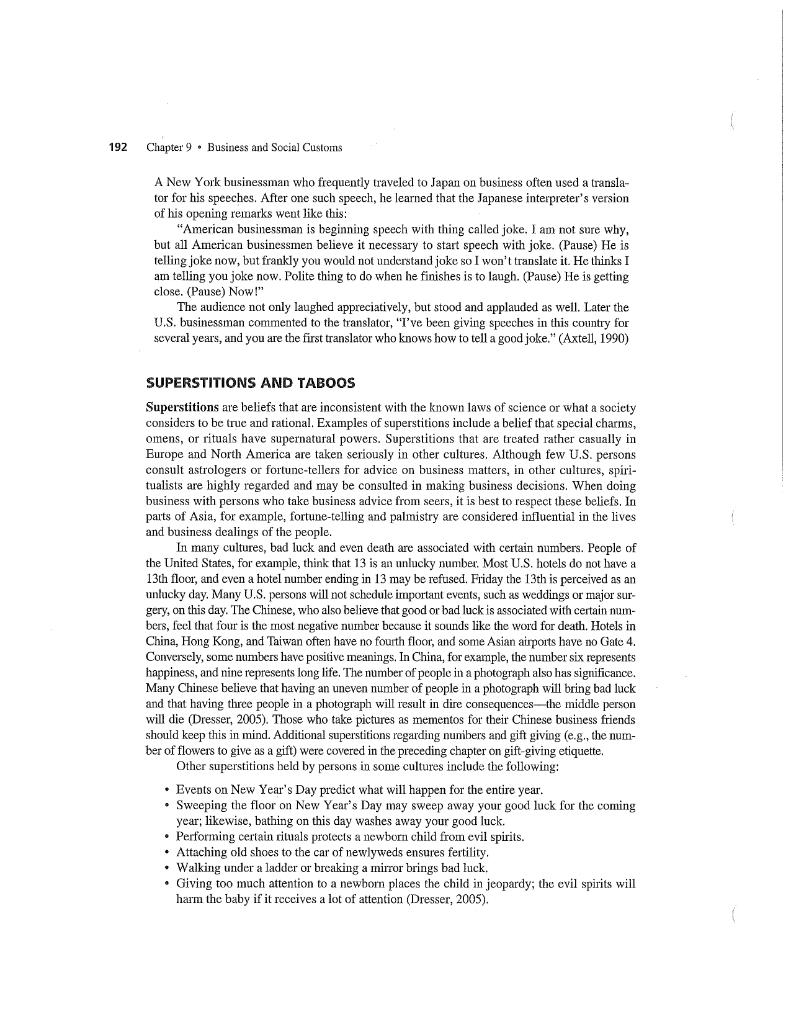
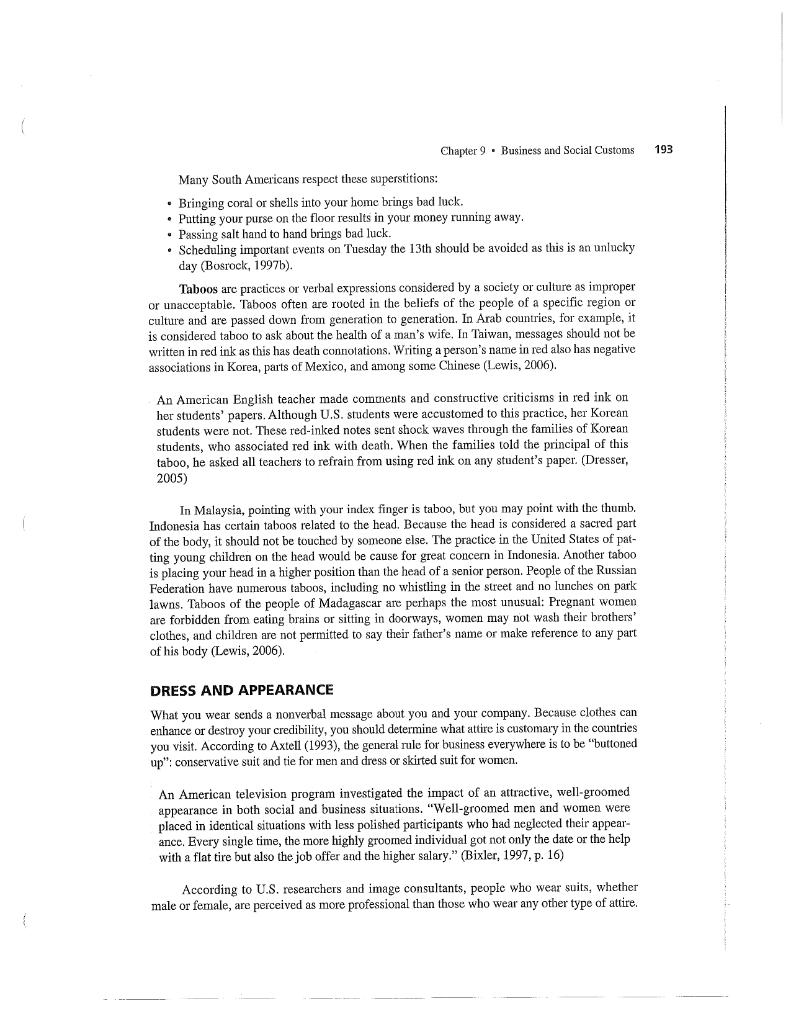
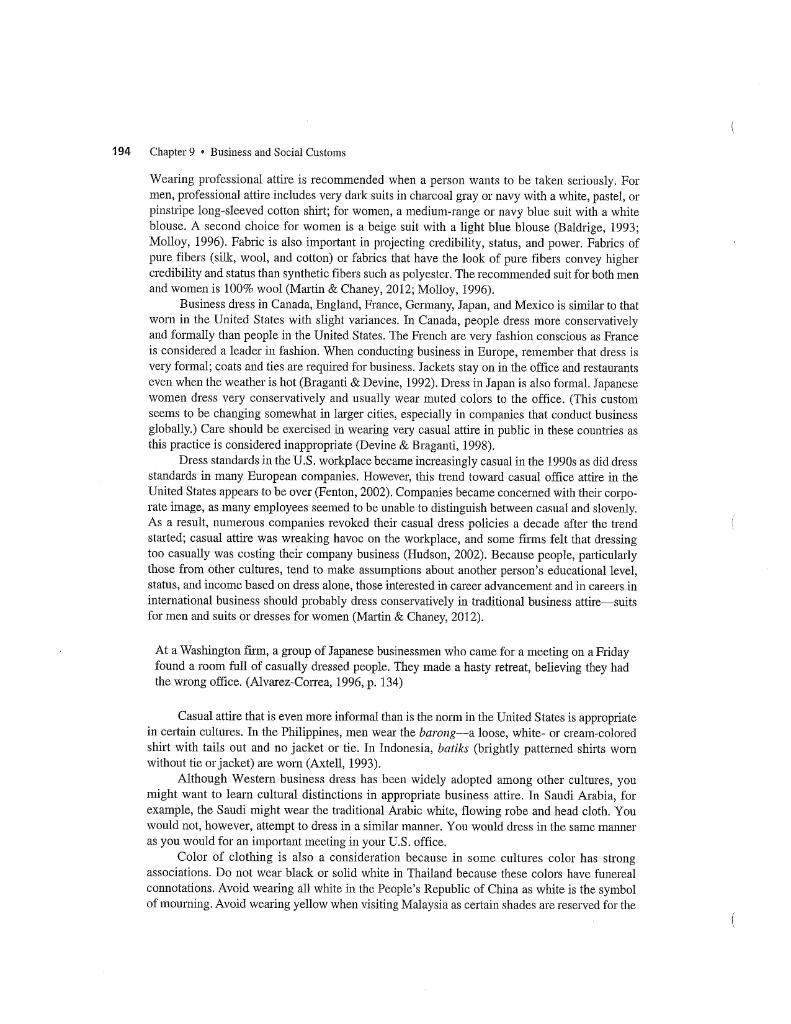
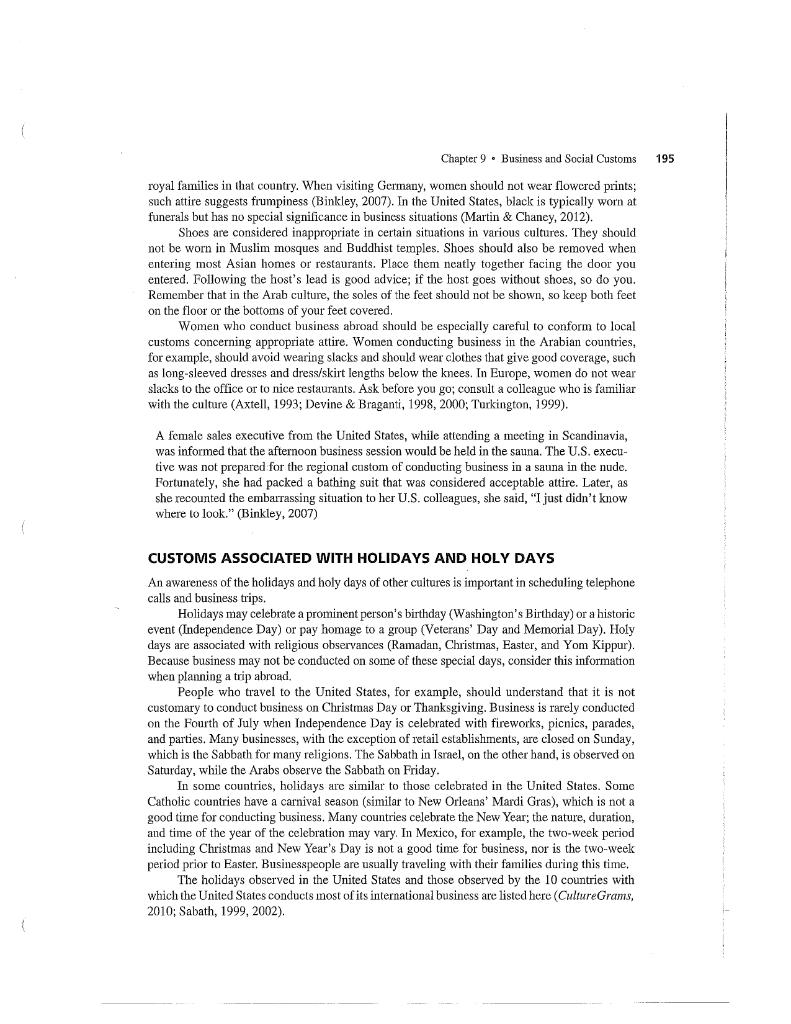
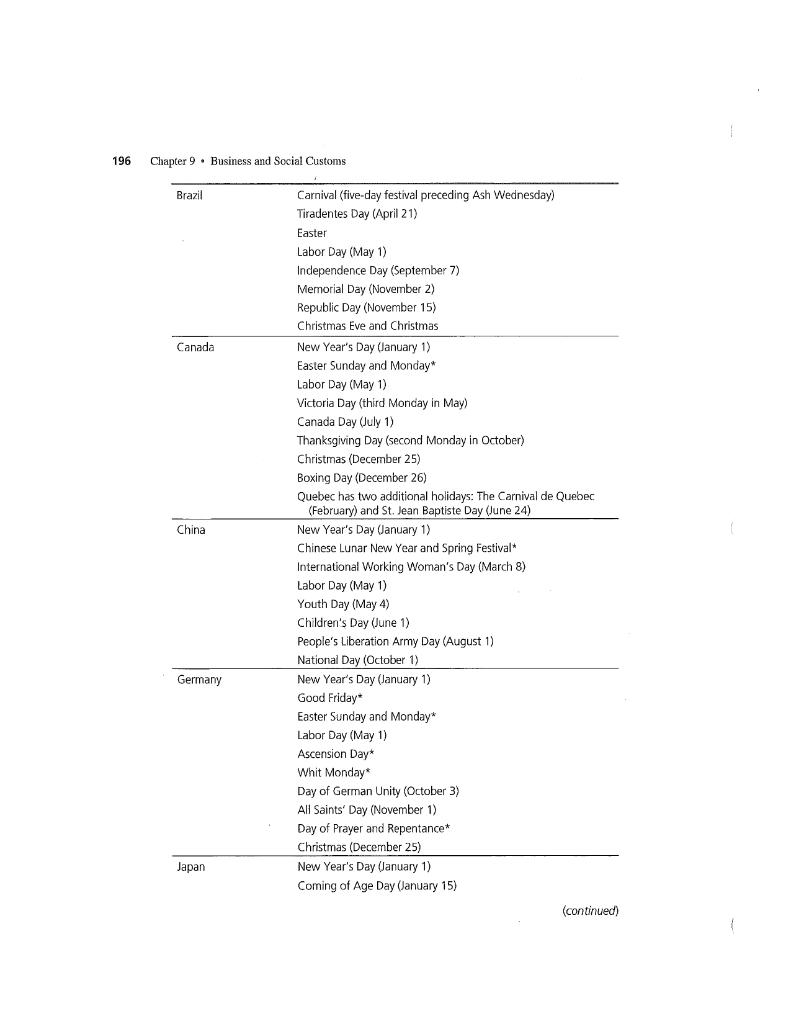
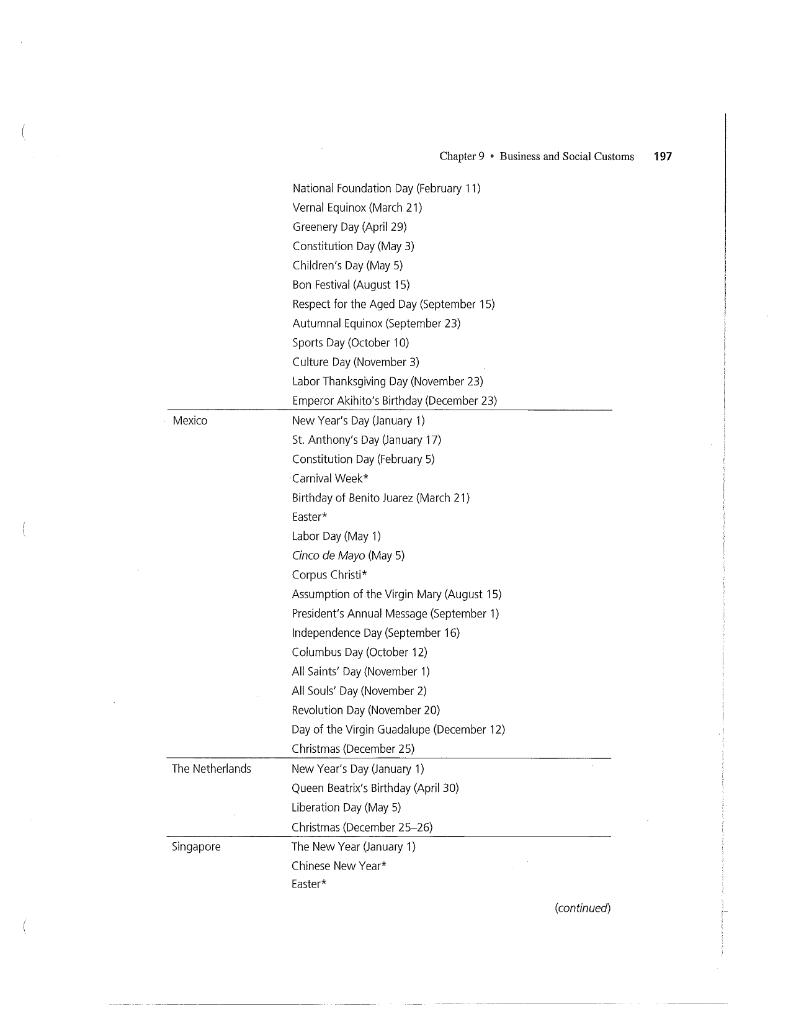
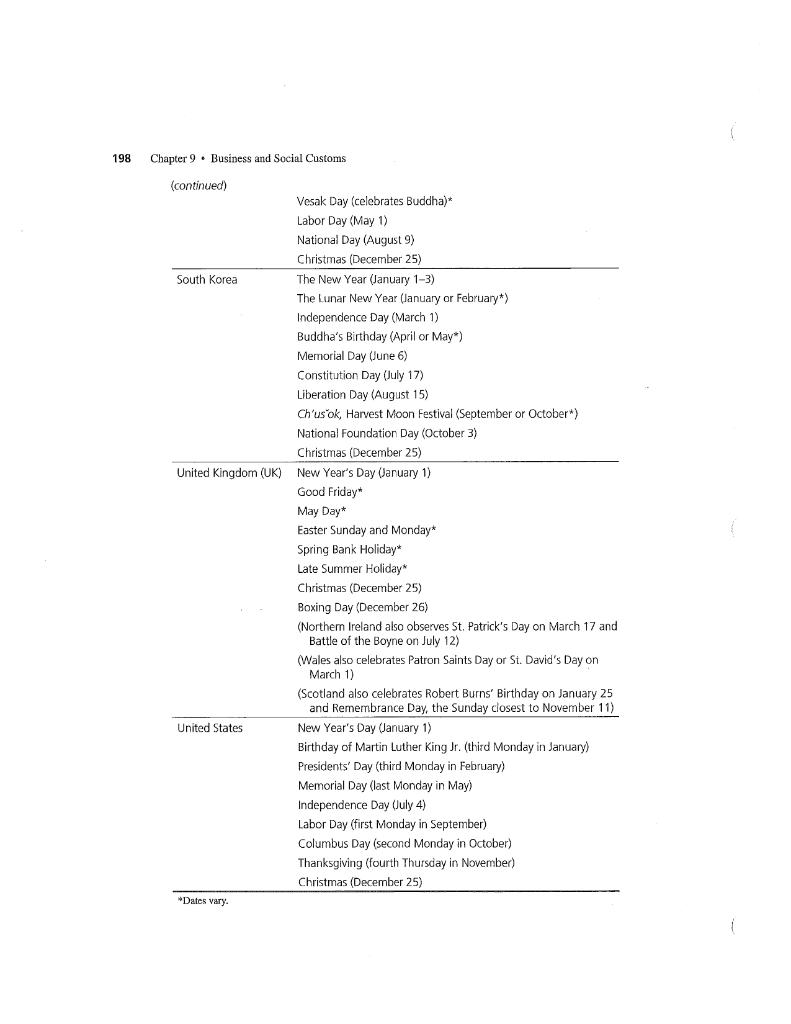
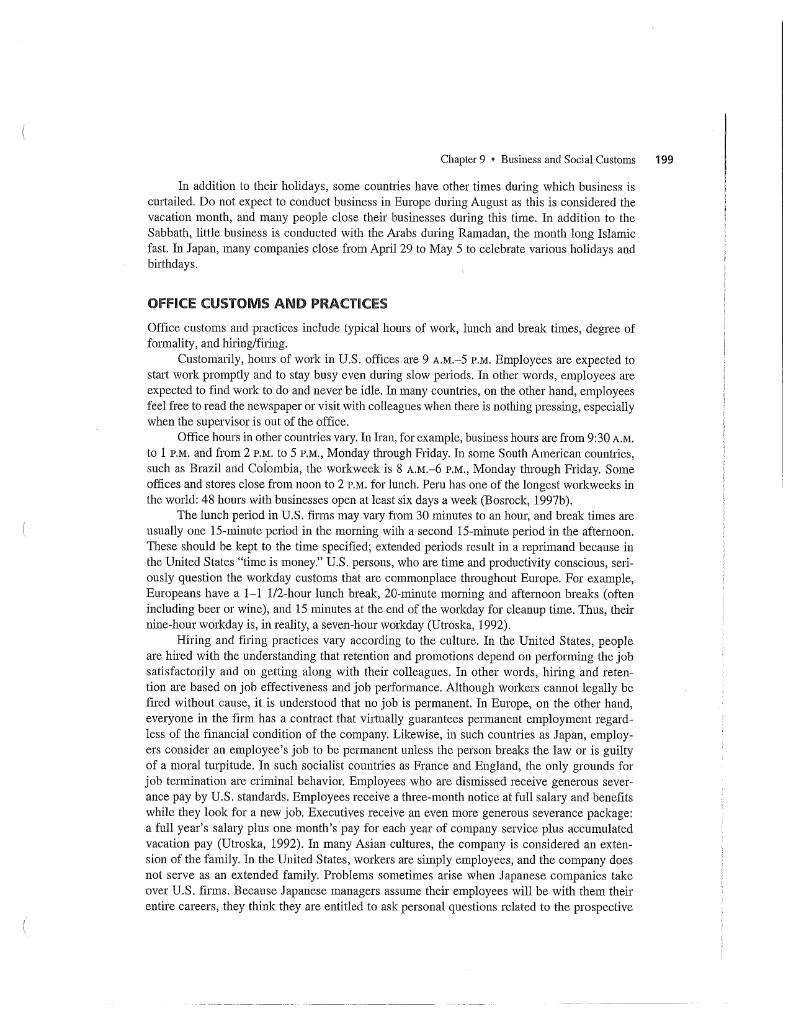
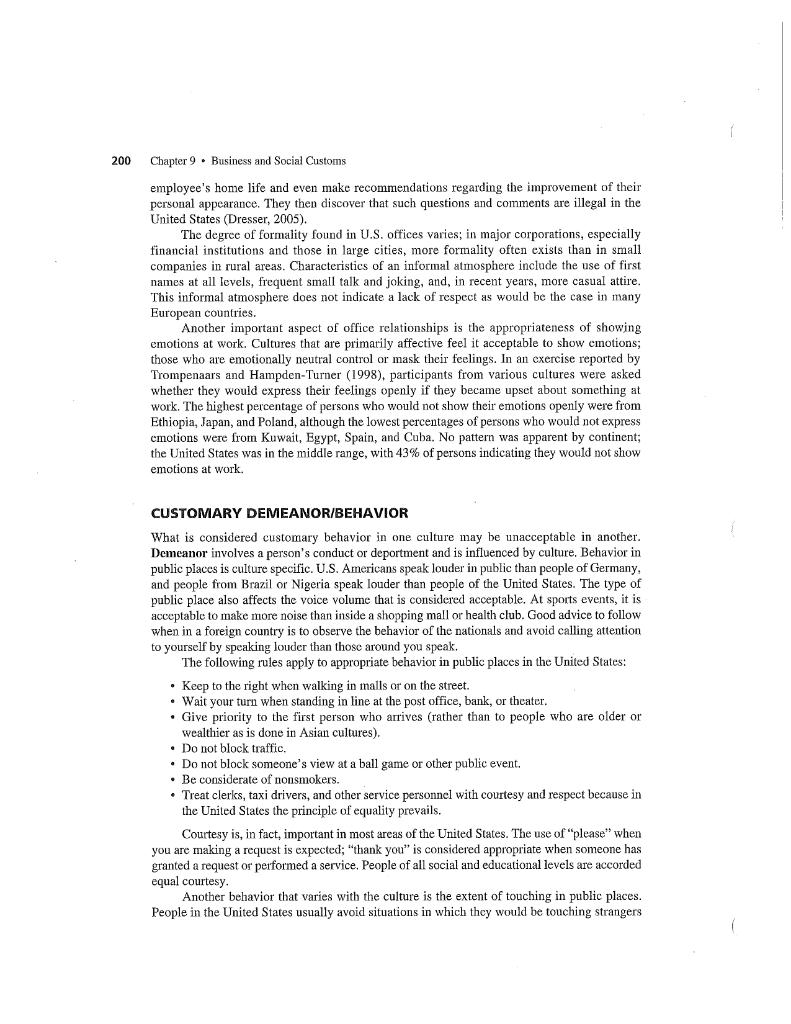


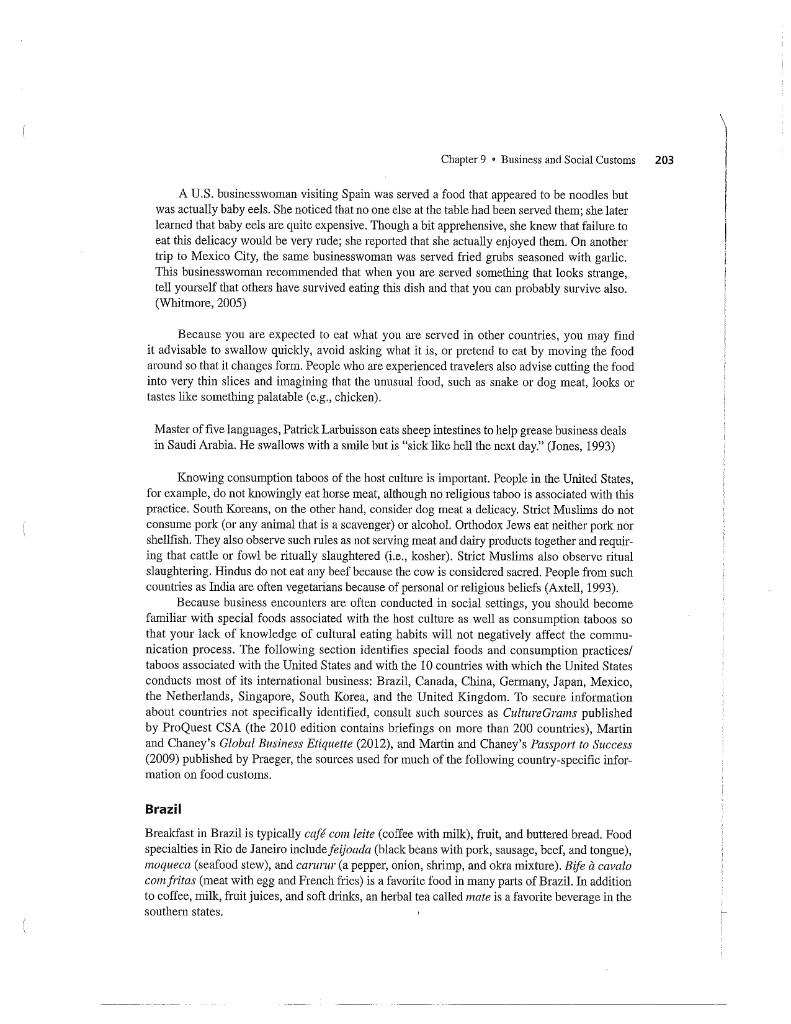
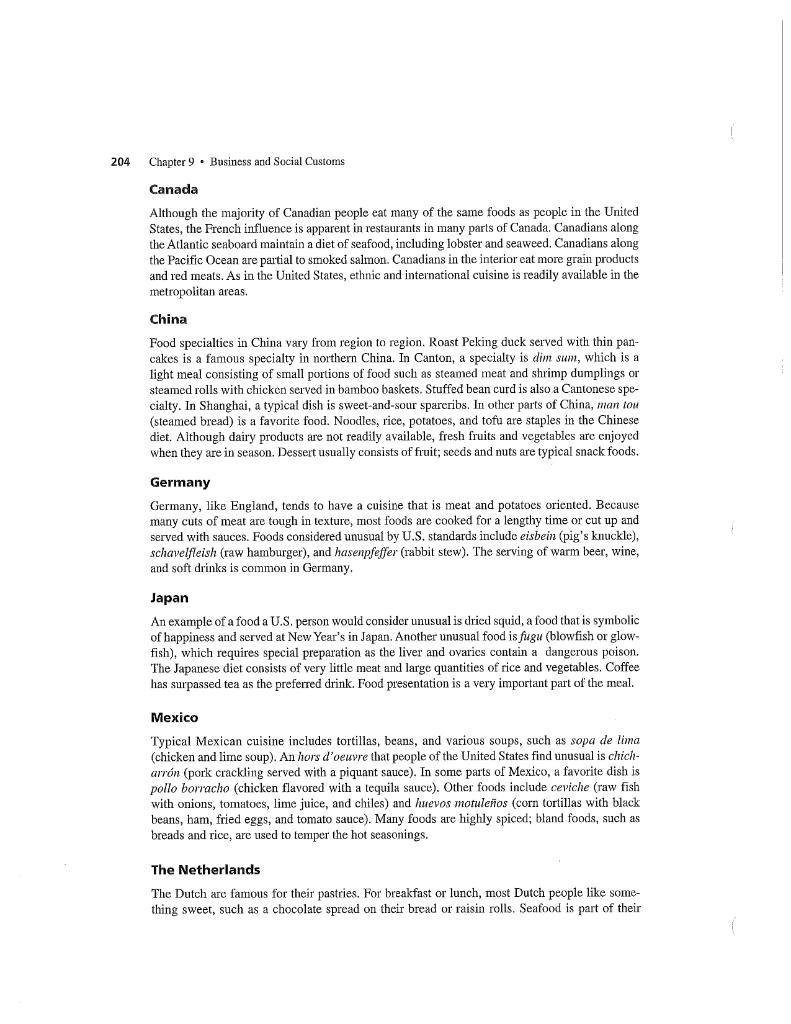
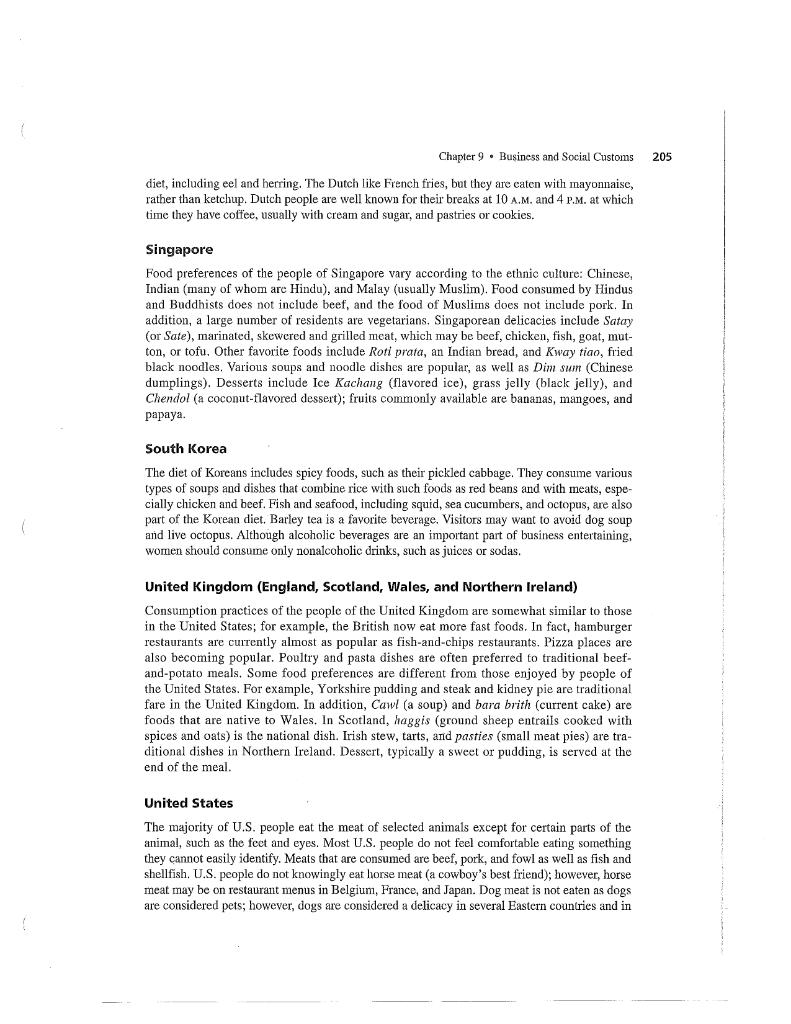

Business and Social Customs Objectives Upon completion of this chapter, you will learn customary verbal expressions of persons of various countries. understand the importance of a knowledge of male/female relationships and workplace equality to successful intercultural communication. learn the roles that humor, superstition, and taboos play in understanding persons of other cultures. understand the role that dress and appearance play in interacting with persons from other countries. learn the importance of knowing about the customs associated with holidays and holy days of the country in which you are traveling or conducting business. understand that office customs vary from culture to culture. understand the importance of appropriate demeanor/behavior in intercultural encounters. recognize that bribery is culturally relative and plays an unofficial role in doing business in many cultures. recognize special food and meal customs considered typical of various cultures and how to show respect for consumption taboos of other countries. ustoms are behaviors generally expected in specific situations and are cstablished, socially acceptable ways of behaving in given circumstances. Customs vary not only by country but also by regions or locations within a country. For example, in the United States, customs differ along north-south lines and urban-rural lines. In addition, religious backgrounds and ethnic identities account for differences in customs. People of the United States have customary behaviors associated with certain holidays, such as eating turkey on Thanksgiving, giving gifts at Christmas, and staying up until midnight Chapter 9 - Business and Social Customs on New Year's Eve. Other customary behaviors are associated with greetings and verbal expressions, male/female relationships, dress and appearance, use of humor, belief in superstitions, and special foods and consumption taboos. Although it is impossible to identify all customs of a particular culture, certain customs are important to conducting business interculturally. Learning the customs of the country with whom you plan to do business shows respect and conveys a sincere commitment to developing a successful business relationship. (Stoller, 2007) VERBAL EXPRESSIONS Although you are not expected to learn the language of every country with whom you may conduct business, if you plan an extended relationship with a particular culture, learning to speak the language (especially commonly used expressions) is important because you may have to communicate with persons who do not speak your language. Make an effort to learn to say such basic expressions as "pleasc" and "thank you," greetings, and other terms commonly used by people in the culture. Examples of such terms in French, German, and Spanish are Histed in Table 9-1. In addition to leaming these expressions, knowing other verbal expressions customarily used in a culture is useful. In the United States, people often respond to someone with a oneword reply: "sure," "okay," and "nope." Although such brevity seems blunt and abrupt by foreign standards, it is simply an indication of the informality typical of U.S. persons. Some expressions are used only in certain regions of the United States. For example, people in the southern United States often say "Y'all come to see us" when bidding someone good-bye. The expected reply is "Thanks! Y'all come to see us, too." This verbal exchange should not be taken as an invitation to visit but is rather only a friendly ritual. In many other cultures and certain regions in the United States, however, such an expression is meant to be an actual invitation to visit (Martin \& Chaney, 2012). Chapter 9 - Business and Social Customs Other expressions, such as "Don't mention it" and "Think nothing of it" in response to a courtesy or favor, are considered rude by persons of other cultures. These expressions, however, are consistent with the U.S. custom that people should be modest and should not brag on themselves. Some persons feel awkward when people compliment or thank them and simply do not know how to respond. When being thanked for a courtesy, a response of "You are welcome" is preferable. Other confusing verbal cxpressions used in the United States are "What's up?" and "How's it going?" Persons for whom English is a second language have no idea what the phrases mean. Avoid using idioms and slang when conversing with new speakers of English because they rely on the literal translation of words. For example, a newcomer to the United States did not accept a job on the "graveyard shift" because he thought he would be working in a cemetery (Dresser, 2005). On meeting someone for the first time, U.S. persons engage in chitchat (small talk or light conversation). Small talk is important in getting to know another person before concentrating on business. In most cultures, starting business without light conversation is rude and insensitive. Chitchat often includes comments about the weather, the physical surroundings, the day's news, or almost anything of a nonsubstantive nature (Baldrige, 1993). People of the United States excel at small talk, as do Canadians and Australians. The British and the French are likewise masters of small talk. In the United States, small talk does not include topies related to politics, religion, personal income, or personal life. Likewise in Saudi Arabia, conversations about family members are usually inappropriate. In Latin America and Mexico, on the other hand, it is not only appropriate to inquire about the health of family members but also to have lengthy discussions about their well-being. Any inquiries in the United States about one's family are brief; for example, "How is your wife?" is answered with "Fine, thanks." Small talk seems to pose problems for people of some cultures. Germans, for example, simply do not believe in it. Swedes, usually fluent in English, have little to say in addition to talking about their jobs, which lasts 1015 minutes. People of Finland actually buy books on the art of small talk (Lewis, 2006). South Americans can talk incessantly for hours, despite their relatively deficient foreign language skills. Author Richard Lewis reported attending an all-Latin American cocktail party in Caracas that lasted from 7 p.M. to 1 A.M. He said, "'There were 300 people prescnt, very little to cat, nobody stopped talking, except to draw breath, for six hours flat; I do not remember a single word that was said." (Lewis, 2006, p. 89) In Asian and Pacific Rim countries, variations exist not only in the use of chitchat but also in the topics that are considered appropriate. The Japanese are uncomfortable with small talk. The Chinese consider small talk useful during initial meetings; appropriate topics include travel experiences and such personal topics as salary and marital status. South Koreans also consider asking personal questions to be appropriate. People of Australia and New Zealand enjoy chitchat and often initiate conversations with strangers in pubs and other public places; they enjoy discussing sports, the weather, and international politics (Martin \& Chaney, 2012). When engaging in chitchat with someone of another culture, the best advice is probably to follow the other person's lead. When a person from another culture talks about his or her family, then talk about yours. If he or she initiates discussions of a political nature, continue the discourse with your own perceptions. MALEIFEMALE RELATIONSHIPS AND WORKPLACE EQUALITY In high-context societies such as the Arab culture, people have definite ideas on what constitutes proper behavior between males and females. In low-context cultures such as the United States, little agreement exists. Both people of the United States and visitors from other cultures have difficulty knowing how to proceed in male/female relationships in the United States because a wide range of behaviors may be observed. A problem with understanding acceptable male/female relationships in any culture is the stereotypes that exist. For example, a stereotype of U.S. women originating primarily from U.S. television shows and movies is that they are aggressive, glamorous, and promiscuous (Axtell, Briggs, Corcoran, \& Lamb, 1997), Correspondingly, U.S. men are viewed as weak men who permit women to dominate them. The equality of men and women in the workplace has been a sensitive issue in the United States. Although 60% of U.S. women of employment age work, they still do not receive equal pay and responsibility. Some U.S. men feel threatened by the more assertive roles many women are assuming. However, most people accept that men and women can work side by side in the workplace and that they can have a friendship that does not have a sexual component. U.S. men and women often have business colleagues of the opposite gender. These work relationships may involve business travel, and no assumption is made about any sexual involvement. In other countries, however, treatment of men and women in the workplace differs substantially from that of the United States. In Mexico, for example, male supervisors customarily kiss their female secretaries on the cheek each morning or embrace them. Despite this custom (seen as undue familiarity by U.S. managers), problems with sexual harassment and gender discrimination are uncommon according to Mexican managers. U.S. managers interviewed, however, reported that Mexican managers do have such problems (Stephens \& Greer, 1995). In the Scandinavian countries, women and men are treated equally. Many Swedish women hold middle-management positions in business. In addition, Swedish women are found in political positions, including parliament. In Iceland, the lirst country to have a woman's party, women are very evident in the workplace. In fact, 70% of women in Iceland have jobs. In Finland, women hold about 38% of positions in parliament. However, women in Finland, like U.S. women, do not earn as much as men (Turkington, 1999). In India, women do not enjoy the same privileges as men; in addition, in Saudi Arabia, women are not considered equal to men. In Bgypt, only one-tenth of workers are women. Although they hold positions as doctors and secretaries, few women hold cxccutive jobs. Korean women have traditionally not held prominent positions in government and business. Although some progress in this area has been made, women still hold low-ranking jobs. China, too, is a male-dominated country; however, women do hold important managerial positions in business (Bosrock, 1997a). Women in the Netherlands comprise less than one-third of the workforce. In the Netherlands 75% of the 71.5% of women who are employed work part time. Women who work outside the home usually have low-paying jobs; few hold managerial positions. A wage gap of 11.3% exists between women and men. Likewise, in Belgium and Germany, women are more likely to be in support staff jobs rather than in managerial positions. In both countries, women seem to be making progress in assuming leadership positions as the younger generation is more accepting of women in higher-level positions (Bosrock, 1995). Brazilian women are not only accepted but are also well respected in business, medicine, and education (Bosrock, 1997b). Chapter 9 Business and Social Customs 191 HUMIOR IN BUSINESS As more and more companies conduct business internationally, frequent opportunities exist for businesspersons to interact in an attempt to develop a good relationship. Using humorous anecdotes is a way of breaking the ice and establishing a relaxed atmosphere prior to the start of business in international meetings. Although humor is a universal human characteristic, what is perceived as humorous varies from culture to culture. In the United States, presentations are often started with a joke or cartoon related to the topic to be covered. In addition to the United States, most European countries use humor during business meetings. The British, especially, intertwine humor in business discussions. When humor is used in business situations with Asian audiences, on the other hand, few are amused (except for Koreans, who seem to appreciate everybody's jokes). British humor is often self-deprecating. Egyptiabs, too, have a good sense of humor that is selfdeprecating. Visitors, however, should not join in. Although it is fine for Egyptians to laugh at themselves, others may not do so (Turkington, 1999). Asian humor finds little merit in jokes about sex, religion, or minorities; however, Asians will laugh out of politeness when a joke is told. They take what is said literally and do not understand U.S. humor. Germans, too, find humor out of place during business meetings. They take business seriously and do not appreciate joking remarks during negotiations. When a presentation in Germany was begun with a cartoon deriding European cultural differences, no one laughed. As the weck progressed, people started laughing both in and out of the sessions. Later the presenters learned that cartoons were not appropriate in a professional setting of strangers. At the conclusion of negotiations, however, Germans enjoy relaxing and telling jokes in local bars or restaurants (Axtell, 1999; Trompenaars \& Hampden-Turner, 1998). Members of cross-cultural teams may have difficulty interpreting teasing and other forms of humor from their colleagues. A U.S. team member working with Australians asked about the meaning of the constant sarcastic remarks and put-downs of other team members. The Australian's response was that the teasing and put-downs show that "we accept you and like you, mate." (Schmidt, Conaway, Easton, \& Wardrope, 2007, pp. 132133 ) Is there such a thing as international humor? Yes-some humor is acceptable internationally, such as slapstick, restaurant jokes, and bumorous stories about golfers. Even in international jokes, however, people have their own nuances to make the jokes/anecdotes amusing to members of their own culture. In the United States, for example, sarcasm and kidding accompany humor; in Australia, humor is barbed and provocative (Lewis, 2006). In some countries, the people enjoy making citizens of a neighboring country the object of their jokes. Belgians, for example, like to direct humor at their neighbors, the Dutch, and likewise the Dutch direct humor at the Belgians. The same is true of the British and the Irish (Axtell, 1999). Some businesspersons with global experience recommend that jokes be avoided with people of diverse cultures; they maintain that American humor is hard to export and appreciate. Even though the intention of humor is to put your international colleagues at ease and create a more relaxed environment, there is great risk of offending someone of another culture or of telling a story that no one understands. In short, we do not all laugh at the same things (Axtell, 1999). 2 Chapter 9 Business and Social Customs A New York businessman who frequently traveled to Japan on business often used a translator for his speeches. After one such speech, he learned that the Japanese interpreter's version of his opening remarks went like this: "American businessman is beginning speech with thing called joke. I am not sure why, but all American businessmen believe it necessary to start speech with joke. (Pause) He is telling joke now, but frankly you would not understand joke so I won't translate it. He thinks I am telling you joke now. Polite thing to do when he finishes is to laugh. (Pause) He is getting close. (Pause) Now!" The audience not only laughed appreciatively, but stood and applauded as well. Later the U.S. businessman commented to the translator, "I've been giving spceches in this country for several years, and you are the first translator who knows how to tell a good joke." (Axtell, 1990) SUPERSTITIONS AND TABOOS Superstitions are beliefs that are inconsistent with the known laws of science or what a society considers to be true and rational. Examples of superstitions include a belief that special charms, omens, or rituals have supernatural powers. Superstitions that are treated rather casually in Europe and North America are taken seriously in other cultures. Although few U.S. persons consult astrologers or fortune-tellers for advice on business matters, in other cultures, spiritualists are highly regarded and may be consulted in making business decisions. When doing business with persons who take business advice from seers, it is best to respect these beliefs. In parts of Asia, for example, fortune-telling and palmistry are considered influential in the lives and business dealings of the people. In many cultures, bad luck and even death are associated with certain numbers. People of the United States, for example, think that 13 is an unlucky number. Most U.S. hotels do not have a 13 th floor, and even a hotel number ending in 13 may be refused. Friday the 13 th is perceived as an unlucky day. Many U.S. persons will not schedule important events, such as weddings or major surgery, on this day. The Chinese, who also believe that good or bad luck is associated with certain numbers, feel that four is the most negative number because it sounds like the word for death. Hotels in China, Hong Kong, and Taiwan often have no fourth floor, and some Asian airports have no Gate 4. Conversely, some numbers have positive meanings. In China, for example, the number six represents happiness, and nine represents long life. The number of people in a photograph also has significance. Many Chinese believe that having an uneven number of people in a photograph will bring bad luck and that having three people in a photograph will result in dire consequences - the middle person will die (Dresser, 2005). Those who take pictures as mementos for their Chinese business friends should keep this in mind. Additional superstitions regarding numibers and gift giving (e.g. the number of flowers to give as a gift) were covered in the preceding chapter on gift-giving etiquette. Other superstitions beld by persons in some cultures include the following: - Events on New Year's Day predict what will happen for the entire year. - Sweeping the floor on New Year's Day may sweep away your good luck for the coming year; likewise, bathing on this day washes away your good luck. - Performing certain riluals protects a newborn child from evil spirits. - Attaching old shoes to the car of newlyweds ensures fertility. - Walking under a ladder or breaking a mirror brings bad luck. - Giving too much attention to a newborn places the child in jeopardy; the evil spirits will harm the baby if it receives a lot of attention (Dresser, 2005). Chapter 9 - Business and Social Customs Many South Americans respect these superstitions: - Bringing coral or shells into your home brings bad luck. - Putting your purse on the floor results in your money running away. - Passing salt hand to hand brings bad luck. - Scheduling important events on Tuesday the 13th should be avoided as this is an unlucky day (Bosrock, 1997b). Taboos are practices or verbal expressions considered by a society or culture as improper or unacceptable. Taboos often are rooted in the beliefs of the people of a specific region or culture and are passed down from generation to generation. In Arab countries, for example, it is considered taboo to ask about the health of a man's wife. In Taiwan, messages should not be written in red ink as this has death connotations. Writing a person's name in red also has negative associations in Korea, parts of Mexico, and among some Chinese (Lewis, 2006). An American English teacher made comments and constructive criticisms in red ink on her students' papers. Although U.S. students were accustomed to this practice, her Korean students were not. These red-inked notes sent shock waves through the families of Korean students, who associated red ink with death. When the families told the principal of this taboo, he asked all teachers to refrain from using red ink on any student's paper. (Dresser, 2005) In Malaysia, pointing with your index finger is taboo, but you may point with the thumb. Indonesia has certain taboos related to the head. Because the head is considered a sacred part of the body, it should not be touched by someone else. The practice in the United States of patting young children on the head would be cause for great concern in Indonesia. Another taboo is placing your head in a higher position tham the head of a senior person. People of the Russian Federation have numerous taboos, including no whistling in the street and no lunches on park lawns. Taboos of the people of Madagascar are perhaps the most unusual: Pregnant women are forbidden from eating brains or sitting in doorways, women may not wash their brothers' clothes, and children are not permitted to say their father's name or make reference to any part of his body (Lewis, 2006). DRESS AND APPEARANCE What you wear sends a nonverbal message about you and your company. Because clothes can enhance or destroy your credibility, you should determine what attire is customary in the countries you visit. According to Axtell (1993), the general rule for business everywhere is to be "buttoned up": conservative suit and tie for men and dress or skirted suit for women. An American television program investigated the impact of an attractive, well-groomed appearance in both social and business situations. "Well-groomed men and women were placed in identical situations with less polished participants who had neglected their appearance. Every single time, the more highly groomed individual got not only the date or the help with a flat tire but also the job offer and the higher salary." (Bixler, 1997, p. 16) According to U.S. researchers and image consultants, people who wear suits, whether male or female, are perceived as more professional than those who wear any other type of attire. Chapter 9 - Business and Social Customs Wearing professional attire is recommended when a person wants to be taken seriously. For men, professional attire includes very dark suits in charcoal gray or navy with a white, pastel, or pinstripe long-sleeved cotton shirt; for women, a medium-range or navy blue suit with a white blouse. A second choice for women is a beige suit with a light blue blouse (Baldrige, 1993; Molloy, 1996). Fabric is also important in projecting credibility, status, and power. Fabrics of pure fibers (silk, wool, and cotton) or fabrics that have the look of pure fibers convey higher credibility and status than synthetic fibers such as polyester. The recommended suit for both men and women is 100% wool (Martin \& Chaney, 2012; Molloy, 1996). Business dress in Canada, England, France, Gcrmany, Japan, and Mexico is similar to that worn in the United States with slight variances. In Canada, people dress more conservatively and formally than people in the United States. The French are very fashion conscious as France is considered a leader in fashion. When conducting business in Europe, remember that dress is very formal; coats and ties are required for business. Jackets stay on in the office and restaurants even when the weather is hot (Braganti \& Devine, 1992). Dress in Japan is also formal. Japanese women dress very conservatively and usually wear muted colors to the office. (This custom seems to be changing somewhat in larger cities, especially in companies that conduct business globally.) Care should be exercised in wearing very casual attire in public in these countries as this practice is considered inappropriate (Devine \& Braganti, 1998). Dress standards in the U.S. workplace became increasingly casual in the 1990s as did dress standards in many European companies. However, this trend toward casual office attire in the United States appears to be over (Fenton, 2002). Companies became concerned with their corporate image, as many employees seemed to be unable to distinguish between casual and slovenly. As a result, numerons companies revoked their casual dress policies a decade after the trend started; casual attire was wreaking havoc on the workplace, and some firms felt that dressing too casually was costing their company business (Hudson, 2002). Because people, particularly those from other cultures, tend to make assumptions about another person's educational level, status, and income bascd on dress alone, those interested in career advancement and in careers in international business should probably dress conservatively in traditional business attire - suits for men and suits or dresses for women (Martin \& Chaney, 2012). At a Washington furm, a group of Japanese businessmen who came for a mecting on a Friday found a room full of casually dressed people. They made a hasty retreat, believing they had the wrong office. (Alvarez-Correa, 1996, p. 134) Casual attire that is even more informal than is the norm in the United States is appropriate in certain cultures. In the Philippines, men wear the barong-a loose, white- or cream-colored shirt with tails out and no jacket or tie. In Indonesia, batiks (brightly patterned shirts worn without tie or jacket) are worn (Axtell, 1993). Although Western business dress has been widely adopted among other cultures, you might want to learn cultural distinctions in appropriate business attire. In Saudi Arabia, for example, the Saudi might wear the traditional Arabic white, flowing robe and head cloth. You would not, however, attempt to dress in a similar manner. Yoa would dress in the same manner as you would for an important meeting in your U.S. office. Color of clothing is also a consideration because in some cultures color has strong associations. Do not wear black or solid white in Thailand because these colors have funereal connotations. Avoid wearing all white in the People's Republic of China as white is the symbol of mourning. Avoid wearing yellow when visiting Malaysia as certain shades are reserved for the A female sales executive from the United States, while attending a meeting in Scandinavia, was informed that the afternoon business session would be held in the sauna. The U.S. executive was not prepared for the regional custom of conducting business in a sauna in the nude. Fortunately, she had packed a bathing suit that was considered acceptable attire. Later, as she recounted the embarrassing situation to her U.S. colleagues, she said, "I just didn't know where to look," (Binkley, 2007) CUSTOMS ASSOCIATED WITH HOLIDAYS AND HOLY DAYS An awareness of the holidays and holy days of other cultures is important in scheduling telephone calls and business trips. Holidays may celebrate a prominent person's birthday (Washington's Birthday) or a historic event (Independence Day) or pay homage to a group (Veterans' Day and Memorial Day). Holy days are associated with religious observances (Ramadan, Christmas, Easter, and Yom Kippur). Because business may not be conducted on some of these special days, consider this information when planning a trip abroad. People who travel to the United States, for example, should understand that it is not customary to conduct business on Christmas Day or Thanksgiving. Business is rarely conducted on the Fourth of July when Independence Day is celebrated with fireworks, picnics, parades, and parties. Many businesses, with the exception of retail establishments, are closed on Sunday, which is the Sabbath for many religions. The Sabbath in Israel, on the other hand, is observed on Saturday, while the Arabs observe the Sabbath on Friday. In some countries, holidays are similar to those celebrated in the United States. Some Catholic countries have a carnival season (similar to New Orleans' Mardi Gras), which is not a good time for conducting business. Many countries celebrate the New Year; the nature, duration, and time of the year of the celebration may vary. In Mexico, for example, the two-week period including Christmas and New Year's Day is not a good time for business, nor is the two-week period prior to Easter, Businesspeople are usually traveling with their families during this time. The holidays observed in the United States and those observed by the 10 countries with which the United States conducts most of its international business are listed here (CulureGrams, 2010; Sabath, 1999, 2002). 196 Chapter 9 Business and Social Customs 197 National Foundation Day (February 11) Vernal Equinox (March 21) Greenery Day (April 29) Constitution Day (May 3) Children's Day (May 5) Bon Festival (August 15) Respect for the Aged Day (September 15) Autumnal Equinox (September 23) Sports Day (October 10) Culture Day (November 3) Labor Thanksgiving Day (November 23) Emperor Akihito's Birthday (December 23) Mexico New Year's Day (January 1) St. Anthony's Day (January 17) Constitution Day (February 5) Carnival Week* Birthday of Benito Juarez (March 21) Easter * Labor Day (May 1) Cinco de Mayo (May 5) Corpus Christi* Assumption of the Virgin Mary (August 15) President's Annual Message (September 1) Independence Day (September 16) Columbus Day (October 12) All Saints' Day (November 1) All Souls' Day (November 2) Revolution Day (November 20) Day of the Virgin Guadalupe (December 12) Christmas \{December 25) The Netherlands New Year's Day (January 1) Queen Beatrix's Birthday (April 30) Liberation Day (May 5) Christmas (December 25-26) Singapore The New Year (January 1) Chinese New Year* Easter* (continued) 198 In addition to their holidays, some countries have other times during which business is curtailed. Do not expect to conduct business in Europe during August as this is considered the vacation month, and many people close their businesses during this time. In addition to the Sabbath, little business is conducted with the Arabs during Ramadan, the month long Islamic fast. In Japan, many companies close from April 29 to May 5 to celebrate various holidays and birthdays. OFFICE CUSTOMS AND PRACTICES Office customs and practices include typical hours of work, lunch and break times, degree of formality, and hiring/firing. Customarily, hours of work in U.S. offices are 9 A.M. 5 P.M. Employees are expected to start work promptly and to stay busy even during slow periods. In other words, employees are expected to find work to do and never be idle. In many countries, on the other hand, employees feel free to read the newspaper or visit with colleagues when there is nothing pressing, especially when the supervisor is out of the office. Office hours in other countries vary. In Iran, for example, business hours are from 9:30 A.M. to 1 P.M. and from 2 P.M. to 5 P.M., Monday through Friday. In some South American countries, such as Brazil and Colombia, the workweek is 8 A.M. 6 P.M., Monday through Friday. Some offices and stores close from noon to 2 P.M. for lunch. Peru has one of the longest workweeks in the world: 48 hours with businesses open at least six days a week (Bosrock, 1997b), The lunch period in U.S. firms may vary from 30 minutes to an hour, and break times are usually one 15-minute period in the morning with a second 15-minute period in the afternoon. These should be kept to the time specified; extended periods result in a reprimand because in the United States "time is money." U.S. persons, who are time and productivity conscious, seriously question the workday customs that are commonplace throughout Europe. For example, Europeans have a 1-1 1/2-hour lunch break, 20-minute morning and afternoon breaks (often including beer or wine), and 15 minutes at the end of the workday for cleanup time. Thus, their nine-hour workday is, in reality, a seven-hour workday (Utroska, 1992). Hiring and firing practices vary according to the culture. In the United States, people are hired with the understanding that retention and promotions depend on performing the job satisfactorily and on getting along with their colleagues. In other words, hiring and retention are based on job effectiveness and job performance. Although workers cannot legally be fired without cause, it is understood that no job is permanent. In Europe, on the other hand, everyone in the firm has a contract that virtally guarantees permanent employment regardIess of the financial condition of the company. Likewise, in such countries as Japan, employers consider an employee's job to be permanent unless the person breaks the law or is guilty of a moral turpitude. In such socialist countries as France and England, the only grounds for job termination are criminal behavior. Employees who are dismissed receive generous severance pay by U.S. standards. Employees receive a three-month notice at full salary and benefits while they look for a new job. Executives receive an even more generous severance package: a full year's salary plus one month's pay for each year of company service plus accumulated vacation pay (Utroska, 1992). In many Asian cultures, the company is considered an extension of the family. In the United States, workers are simply employees, and the company does not serve as an extended family. Problems sometimes arise when Japanese companies take over U.S. firms. Because Japanese managers assume their employees will be with them their entire careers, they think they are entitled to ask personal questions related to the prospective Chapter 9 - Business and Social Customs employee's home life and even make recommendations regarding the improvement of their personal appearance. They then discover that such questions and comments are illegal in the Wnited States (Dresser, 2005). The degree of formality found in U.S. offices varies; in major corporations, especially financial institutions and those in large cities, more formality often exists than in small companies in rural areas. Characteristics of an informal atmosphere include the use of first names at all levels, frequent small talk and joking, and, in recent years, more casual attire. This informal atmosphere does not indicate a lack of respect as would be the case in many European countries. Another important aspect of office relationships is the appropriateness of showing emotions at work. Cultures that are primatily affective feel it acceptable to show cmotions; those who are emotionally neutral control or mask their feelings. In an exercise reported by Trompenaars and Hampden-Turner (1998), participants from various cultures were asked whether they would express their feelings openly if they became upset about something at work. The highest percentage of persons who would not show their emotions openly were from Ethiopia, Japan, and Poland, although the lowest percentages of persons who would not express emotions were from Kuwait, Egypt, Spain, and Cuba. No pattern was apparent by continent; the United States was in the middle range, with 43% of persons indicating they would not show emotions at work. CUSTOMARY DEMEANOR/BEHAVIOR What is considered customary behavior in one culture may be unacceptable in another. Demeanor involves a person's conduct or deportment and is influenced by culture. Behavior in public places is cuIture specific. U.S. Americans speak louder in public than people of Germany, and people from Brazil or Nigeria speak louder than people of the United States. The type of public place also affects the voice volume that is considered acceptable. At sports events, it is acceptable to make more noise than inside a shopping mall or health club. Good advice to follow when in a foreign country is to observe the behavior of the nationals and avoid calling attention to yourself by speaking louder than those around you speak. The following rules apply to appropriate behavior in public places in the United States: - Keep to the right when walking in malls or on the street. - Wait your turn when standing in line at the post office, bank, or theater. - Give priority to the first person who arrives (rather than to people who are older or wealthier as is done in Asian cultures). - Do not block traffic. - Do not block someone's view at a ball game or other public event. - Be considerate of nonsmokers. - Treat clerks, taxi drivers, and other service personnel with courtesy and respect because in the United States the principle of equality prevails. Courtesy is, in fact, important in most areas of the United States. The use of "please" when you are making a request is expected; "thank you" is considered appropriate when someone has granted a request or performed a service. People of all social and educational levels are accorded equal courtesy. Another behavior that varies with the culture is the extent of touching in public places. People in the United States usually avoid situations in which they would be touching strangers Chapter 9 Business and Social Customs in public. They avoid getting on a crowded elevator because they are uncomfortable with physical contact. If they must get on a crowded elevator, they observe "elevator etiquette," refraining from speaking, facing the front, and watching the floor indicator. One exception seems to be subway trains, where people are often too crowded to move. People in South America, on the other hand, think nothing of squeezing onto a crowded bus or elevator and pushing through a crowd. A behavior of U.S. Americans that seems unusual to those of many other countries is doing "menial" jobs. In fact, the United States is often referred to as a "do-it-yourself" society. Regardless of wealth, position, or social standing, people of the United States are often found mowing their lawn, washing their car, or building a patio. Reasons for this custom vary; some U.S. persons point out that hiring household help or a gardener represents a loss of privacy. Others reason that they prefer to do the work themselves and use the money they would spend on service personnel for vacations, sports, and labor-saving appliances. When both adults work, home cleaning services or domestic help may be used for a limited number of hours each week. In many European and South American countries, on the other hand, numerous service people are often employed by businesspersons, government officials, and professionals. Households commonly have a cook, maid, and gardener. BRIBERY A custom that has undergone close scrutiny in the past few years is bribery. Bribery is giving or promising something, often money, to influence another person's actions. In Mexico, bribes are known as mordida; in Southeast Asia, kumshaw; and in the Middle East, baksheesh. Although bribery is not officially sanctioned or condoned in any country, it is unofficially a part of business in many cultures. The practice is often referred to as "greasing the palm" and is considered neither unethical nor immoral in a number of countries. In Nigeria, for example, a person must pay the customs agent in order to leave the airport; in Thailand and Indonesia, getting a driver's license involves giving a tip to an agent (Engholm \& Rowland, 1996). According to Indonesians, bribery saves time and effort when dealing with top officials who make final decisions. In this country businesspeople have found that bribing a top government official to get a big contract is far less time consuming than preparing a good proposal for bidding. (Hodge, 2000, p. 222) The United States has the most restrictive laws against bribery in the world. Companies found guilty of paying bribes to foreign officials can be fined up to $1 million, and guilty employees may be fined up to $10,000 (Engholm, 1991). Many U.S. competitors, including Italian, German, and Japanese firms, not only use bribery in international transactions but also may deduct the amount of the bribe on their taxes as a necessary business expense. Mike Lorelli of Pizza Hut shared this experience related to bribery in other cultures: In the Middle East or Brazil, they would think you are crazy for not offering a bribe because to them there is absolutely nothing wrong with bribery. You're an oddball, but there is not a thing you can do about it, (Engholm \& Rowland, 1996, p. 133) 2 Chapter 9 - Business and Social Customs Managers in the United States are faced with situations that are considered illegal in their country and that are not only lawful but also an accepted paut of doing business in other countries. They must, therefore, be aware that as business becomes globalized, different perceptions exist regarding the appropriateness of certain incentives. What is perceived as bribery is culturally relative just as a person's conscience can become "culturally conditioned." What is considered a tip (to ensure promptness) in one culture is considered illegal in another (Moran, Haris, \& Moran, 2011). Although people of the United States are not legally permitted to accept bribes, many U.S. businesspersons provide favorite clients with box seats at sporting events or entertain them lavishly (Dresser, 2005). Some consider this practice a form of bribery. Additional information on bribery is presented in chapter 12. SPECIAL FOODS AND CONSUMPTION TABOOS Most cultures have unusual foods that are viewed with surprise or even disdain by persons in other cultures. Foods that are common in the United States that people in other cultures find unusual include corn on the cob (in some countries considered a food for animals), grits, popcorn, marshmallows, and crawfish (Axtell, 1993) (see Figure 9-1). Foods in other cultures that concern some U.S. Americans include Japanese sushi (raw fish), shark fin soup in Hong Kong, dog meat in South Korea, and sheep's eyeballs in Saudi Arabia. In parts of Mexico, chicken soup may contain the chicken's feet; in China, you may be served duck's feet (see Figure 9-2). A college professor from the United States who had just arrived in La Paz, Bolivia, for a twoyear teaching assignment at the local university was invited to dine with U.S. colleagues at a well-known local restaturant. She was assured that the best dinner choice was the eatery's specialty, mixed grill - a variety of meats grilled at the table. After consuming one chewy morsel, she made the mistake of asking what it was. The reply: stuffed cow's teats! (Martin \& Chaney, 2012, p. 113) FIGURE 9-1 Popcorn (a), FIGURE 9-2 Sheep's Eyeballs Crawfish (b), and Corn on (a), Snake (b), and Chicken Soup the Cob(c) Containing the Feet (c) Chapter 9 Business and Social Customs 203 A U.S. businesswoman visiting Spain was served a food that appeared to be noodles but was actually baby eels. She noticed that no one else at the table had been served them; she later learned that baby eels are quite expensive. Though a bit apprehensive, she knew that failure to eat this delicacy would be very rude; she reported that she actually enjoyed them. On another trip to Mexico City, the same businesswoman was served fried grubs seasoned with garlic. This businesswoman recommended that when you are served something that looks strange, tell yourself that others have survived eating this dish and that you can probably survive also. (Whitmore, 2005) Because you are expected to eat what you are served in other countries, you may find it advisable to swallow quickly, avoid asking what it is, or pretend to eat by moving the food around so that it changes form. People who are experienced travelers also advise cutting the food into very thin slices and imagining that the unusual food, such as snake or dog meat, looks or tastes like something palatable (c.g., chicken). Master of five languages, Patrick Larbuisson eats sheep intestines to help grease business deals in Saudi Arabia. He swallows with a smile but is "sick like hell the next day." (Jones, 1993) Knowing consumption taboos of the host culture is important. People in the United States, for example, do not knowingly eat horse meat, although no religious taboo is associated with this practice. South Koreans, on the other hand, consider dog meat a delicacy. Strict Muslims do not consume pork (or any animal that is a scavenger) or alcohol. Orthodox Jews eat neither pork nor shellfish. They also observe such rules as not serving meat and dairy products together and requiring that cattle or fowl be ritually slaughtered (i.e., kosher). Strict Muslims also observe ritual slaughtering. Hindus do not eat any beef because the cow is considered sacred. People from such countries as India are often vegetarians because of personal or religious beliefs (Axtell, 1993). Because business encounters are often conducted in social settings, you should become familiar with special foods associated with the host culture as well as consumption taboos so that your lack of knowledge of cultural eating habits will not negatively affect the communication process. The following section identifies special foods and consumption practices/ taboos associated with the United States and with the 10 countries with which the United States conducts most of its international business: Brazil, Canada, China, Germany, Japan, Mexico, the Netherlands, Singapore, South Korea, and the United Kingdom. To secure information about countries not specifically identified, consult such sources as CultureGrams published by ProQuest CSA (the 2010 edition contains briefings on more than 200 countries), Martin and Chaney's Global Business Etiquelte (2012), and Martin and Chaney's Passport to Stccess (2009) published by Praeger, the sources used for much of the following country-specific information on food customs. Brazil Breakfast in Brazil is typically caf com leite (colfee with milk), fruit, and buttered bread. Food specialties in Rio de Janeiro include feijoada (black beans with pork, sausage, beef, and tongue), moqueca (seafood stew), and carurw (a pepper, onion, shrimp, and okra mixture). Bife cavalo com fritas (meat with egg and French fries) is a favorite food in many parts of Brazil. In addition to coffee, milk, fruit juices, and soft drinks, an herbal tea called mate is a favorite beverage in the southern states. Chapter 9 - Business and Social Customs Canada Although the majority of Canadian people eat many of the same foods as people in the United States, the French influence is apparent in restaurants in many parts of Canada. Canadians along the Atlantic seaboard maintain a diet of seafood, including lobster and seaweed. Canadians along the Pacific Ocean are partial to smoked samon. Canadians in the interior eat more grain products and red meats. As in the United States, ethnic and international cuisine is readily available in the metropolitan areas. China Food specialties in China vary from region to region. Roast Peking duck served with thin pancakes is a famous specialty in northern China. In Canton, a specialty is dim sum, which is a light meal consisting of small portions of food such as steamed meat and shrimp dumplings or steamed rolls with chicken served in bamboo baskets. Stuffed bean curd is also a Cantonese specialty. In Shanghai, a typical dish is sweet-and-sour spareribs. In other parts of China, man tou (steamed bread) is a favorite food. Noodles, rice, potatoes, and tofu are staples in the Chinese diet. Although dairy products are not readily available, fresh fruits and vegetables are enjoyed when they are in season. Dessert usually consists of fruit; seeds and nuts are typical snack foods. Germany Germany, like England, tends to have a cuisine that is meat and potatoes oriented. Because many cuts of meat are tough in texture, most foods are cooked for a lengthy time or cut up and served with sauces. Foods considered unusual by U.S. standards include eisbein (pig's knuckle), schavelfleish (raw hamburger), and hasenpfeffer (rabbit stew). The serving of warm beer, wine, and soft drinks is common in Germany. Japan An example of a food a U.S. person would consider unusual is dried squid, a food that is symbolic of happiness and served at New Year's in Japan. Another unusual food is fugu (blowfish or glowfish), which requires special preparation as the liver and ovarics contain a dangerous poison. The Japanese diet consists of very little meat and large quantities of rice and vegetables. Coffee has surpassed tea as the preferred drink. Food presentation is a very important part of the meal. Mexico Typical Mexican cuisine includes tortillas, beans, and various soups, such as sopa de lima (chicken and lime soup). An hors d'oeuve that people of the United States find unusual is chicharrn (pork crackling served with a piquant sauce). In some parts of Mexico, a favorite dish is pollo borracho (chicken flavored with a tequili sauce). Other foods include ceviche (raw fish with onions, tomatoes, lime juice, and chiles) and huevos motulenos (corn tortillas with black beans, ham, fried eggs, and tomato sauce). Many foods are highly spiced; bland foods, such as breads and rice, are used to temper the hot seasonings. The Netherlands The Dutch are famous for their pastries. For breakfast or lunch, most Dutch people like something sweet, such as a chocolate spread on their bread or raisin rolls. Seafood is part of their Chapter 9 Business and Social Customs diet, including eel and herring. The Dutch like French fries, but they are eaten with mayonnaise, rather than ketchup. Dutch people are well known for their breaks at 10 A.M. and 4 P.M. at which time they have coffee, usually with cream and sugar, and pastries or cookies. Singapore Food preferences of the people of Singapore vary according to the ethnic culture: Chinese, Indian (many of whom are Hindu), and Malay (usually Muslim). Food consumed by Hindus and Buddhists does not include beef, and the food of Muslims does not include pork. In addition, a large number of residents are vegetarians. Singaporean delicacies include Satay (or Sate), marinated, skewered and grilled meat, which may be beef, chicken, fish, goat, mutton, or tofu. Other favorite foods include Roti prata, an Indian bread, and Kway tiao, fried black noodles. Various soups and noodle dishes are popular, as well as Dim sum (Chinese dumplings). Desserts include Ice Kachang (flavored ice), grass jelly (black jelly), and Chendol (a coconut-flavored dessert); fruits commonly available are bananas, mangoes, and papaya. South Korea The diet of Koreans includes spicy foods, such as their pickled cabbage. They consume various types of soups and dishes that combine rice with such foods as red beans and with meats, especially chicken and beef. Fish and seafood, including squid, sea cucumbers, and octopus, are also part of the Korean diet. Barley tea is a favorite beverage. Visitors may want to avoid dog soup and live octopus. Although alcoholic beverages are an important part of business entertaining, women should consume only nonalcoholic drinks, such as juices or sodas. United Kingdom (England, Scotland, Wales, and Northern Ireland) Consumption practices of the people of the United Kingdom are somewhat similar to those in the United States; for example, the British now eat more fast foods. In fact, hamburger restaurants are currently almost as popular as fish-and-chips restaurants. Pizza places are also becoming popular. Poultry and pasta dishes are often preferred to traditional beefand-potato meals. Some food preferences are different from those enjoyed by people of the United States. For example, Yorkshire pudding and steak and kidney pie are traditional fare in the United Kingdom. In addition, Cawl (a soup) and bara brith (current cake) are foods that are native to Wales. In Scotland, haggis (ground sheep entrails cooked with spices and oats) is the national dish. Irish stew, tarts, and pasties (small meat pies) are traditional dishes in Northern Ireland. Dessert, typically a sweet or pudding, is served at the end of the meal. United States The majority of U.S. people eat the meat of selected animals except for certain parts of the animal, such as the feet and eyes. Most U.S. people do not feel comfortable eating something they cannot easily identify. Meats that are consumed are beef, pork, and fowl as well as fish and shellfish. U.S. people do not knowingly eat horse meat (a cowboy's best friend); however, horse meat may be on restaurant menus in Belgium, France, and Japan. Dog meat is not eaten as dogs are considered pets; however, dogs are considered a delicacy in several Eastern countries and in Based on Read Business and Social Customs Handout. please provide Four things that intrigued or surprised you and Two questions that you want to ask from any senior


























